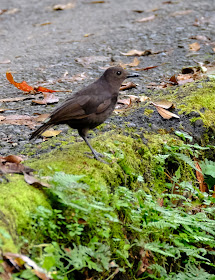This is my first Treepie that I have encounter. The other one to see is the Racquet-tailed Treepie in Perlis Chuping side near to Thai Border. It is often seen in small flock accompanying other birds like the Bornean Green Magpie
It is fairly common in most mountain ranges in the northern and central parts of Borneo. It mainly occurs between 300 and 2,800 metres above sea-level, being most common in valleys and foothills at the lower end of that range. It inhabits forest, forest edge, bambo thickets and scrubland and is sometimes seen in cultivated areas. It forages in the tree canopy, alone or in small groups, searching for small fruit, seeds and large insects such as beetles and cockroaches. It can become tame, visiting villages to feed on scraps.
Little is known about its breeding habits. The nest is shallow, built of fine twigs and placed in a low tree. The eggs are greenish-white with brown markings concentrated in a ring at the wider end.
Adult has blackish-brown forehead, lores and cheek, crown to nape and rest of upperparts silvery grey, wings black with white wing patch at base of primaries. Long uppertail feathers grey with broad black terminal band. Neck and rest of underparts fawn brown. Black under-tail feathers are of progressive length and are much shorter than uppertail feathers. Iris reddish brown; bill, legs and feet black.
The Bornean treepie is a noisy bird with a variety of loud, explosive calls including a bell-like whistle and various grunting and chattering calls. It is able to mimic the calls of other birds.













